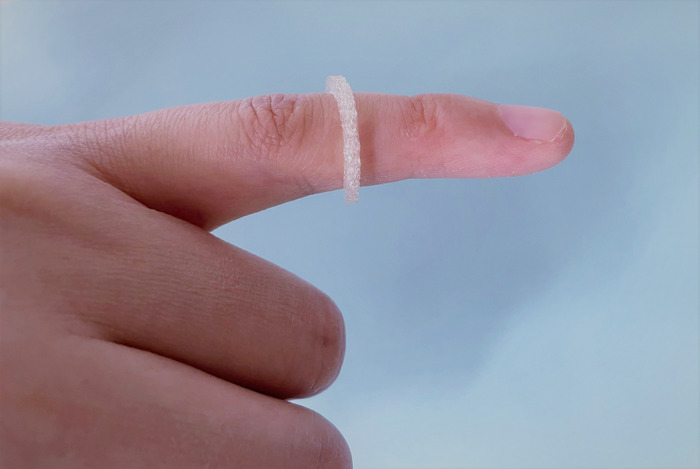
This is what the ring looks like that could help repel insects.
CREDIT: Uni Halle / Fanfan Du
A new type of insect-repellent delivery device has been developed by scientists from the Martin Luther University Halle-Wittenberg (MLU). With the help of a 3D printer, the active ingredient is first “encapsulated” and formed into the desired shape, such as a ring, which can then be worn and releases an agent designed to repel mosquitoes for a long time.
The team has presented its work in the International Journal of Pharmaceutics.
The researchers have developed their prototypes using “IR3535”, an insect repellent developed by MERCK. “Mosquito sprays containing IR3535 are very gentle on the skin and have been used all over the world for many years. That’s why we’ve been using the agent for our experiments”, says Professor René Androsch from the MLU. It is usually applied as a spray or lotion and offers several hours of protection. However, Androsch and his team are looking for ways to release the agent over a much longer period, such as by encapsulating it in a wearable ring or bracelet.
The researchers have succeeded in using a special 3D printing technique to insert the insect repellent into a biodegradable polymer in a controlled manner and to shape the mixture of substances in various ways. “The basic idea is that the insect repellent continuously evaporates and forms a barrier for insects”, explains the lead author of the study, Fanfan Du, a doctoral candidate at the MLU. The rate at which the insect repellent evaporates depends on many different factors, including temperature, concentration and the structure of the polymer used. After conducting various experiments and simulations, the team predicts that the insect repellent needs well over a week to evaporate completely at a temperature of 37°C (98,6 °F, i.e., body temperature).
While the researchers have proven that it is absolutely possible to develop a wearable insect repellent, the rings and other forms created for the study are only prototypes. According to Androsch, further research needs to be carried out to determine how well the rings function under actual conditions. The encapsulation material could also be further optimised.
Original Article: Scientists develop a new kind of printable, wearable insect repellent
More from: Martin Luther University of Halle-Wittenberg
The Latest Updates from Bing News
Go deeper with Bing News on:
Insect-repellent delivery device
- Mozz Guard Reviews United States HIDDEN DANGER Every Customer Must Know Before Making A Purchase!!!
This maintenance primarily involves cleaning the device and checking for any damaged parts. Refer to the Mozz Guard user manual for detailed maintenance guidelines. Can I use Mozz Guard in combination ...
- Even Shoppers Who Usually Get ‘Eaten Alive’ Say This Mosquito Repellent Lantern Is a ‘Game Changer’
This Thermacell mosquito repellent lantern allows shoppers to sit outside for hours without getting bitten. The device has little to no smell, and it doubles as an outdoor light. Shop it for $28 at ...
- Top 6 Best Essential Oils for Mosquito Repellents in 2024
When it comes to mosquito repellent, there are several essential oils that are known to be effective. These include citronella, lemon eucalyptus, lavender, peppermint, and tea tree oil.
- The Best Tick-Repellent Clothing to Ward Off Big, Bad Bugs
In addition to conventional defenses like insect repellents, you can buy clothing designed and chemically treated to minimize your risk of getting targeted by ticks. We’ve put together a primer ...
- Mozz Guard Reviews: Does This Portable Bug Zapper Really Work?
Discover a mosquito-free summer with Mozz Guard, the portable bug zapper with advanced UV technology. Enjoy 14+ hours of protection with our rechargeable, chemical-free device—safe for kids and pets!
Go deeper with Bing News on:
Wearable insect repellent
- Heat Rash To Dehydration: BEWARE Of These 6 Summer Skin Problems
During the summer months, various skin problems can arise due to increased sun exposure, higher temperatures, humidity, and other factors. Here are s ...
- Here’s what to do if you are bitten by a tick, according to experts
According to the Centers for Disease Control and Prevention (CDC), you should conduct a tick check of the entire body within 12 to 24 hours of outdoor activities. That includes checking under the arms ...
- A bacterial disease is infecting beavers and other wild mammals in Utah
Beavers across the state have recently tested positive for a deadly bacterial disease. As of mid-April, nine beavers have died from tularemia in Utah.
- It's another bad season for ticks in Pennsylvania
The state's tick specialist says every season is a bad one for ticks because they carry things that can make us sick.
- Even Shoppers Who Usually Get ‘Eaten Alive’ Say This Mosquito Repellent Lantern Is a ‘Game Changer’
This Thermacell mosquito repellent lantern allows shoppers to sit outside for hours without getting bitten. The device has little to no smell, and it doubles as an outdoor light. Shop it for $28 at ...










